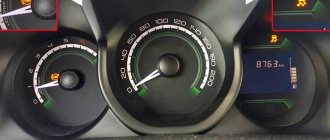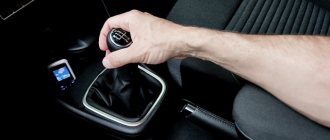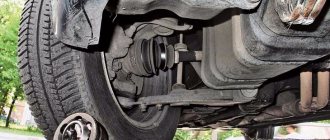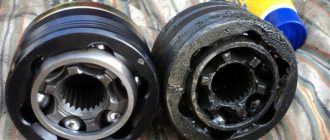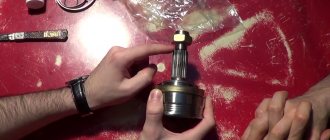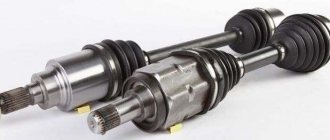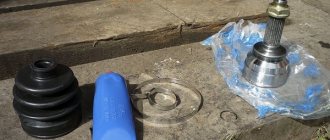A faulty steering system must be repaired immediately at the first symptoms that indicate a breakdown. One of the most common breakdowns of the control unit is a crunching sound when turning the steering wheel; if you find such a breakdown, do not delay in diagnosing and repairing it. How to diagnose a steering failure? Everyone has their own answer to this question - for some it is easier to contact a service, while others prefer to do any repairs themselves. Both are right in their own way; both cases have their own “pros” and “cons.” As for the diagnosis and repair of the helmsman at the station, the main advantage can be considered the presence of a professional. equipment, as well as extensive experience among the “servicemen”, which will allow you to quickly and efficiently not only diagnose the breakdown, but also eliminate it in the shortest possible time. The only drawback is that the service is not free, and steering repair is not just changing the pads; the price tag will be appropriate. Therefore, it is up to you to decide how to deal with the problem.
The difficulty of diagnosing a faulty steering wheel lies in the fact that when turning the steering wheel, you “address” not only the steering rack; many components are involved in the work: tie rods and ends, CV joints, wheels and more. Therefore, it is impossible to say exactly what causes the crunch when turning the steering wheel; moreover, it may not be related to the steering mechanism at all.
CV joint
This failure is very similar to a CV joint crunching, so you should use the method of elimination, checking this failure first. If you notice a crunching sound while driving, most likely the reason will be related to the CV joint. The “grenade”, which is what the constant velocity joint (CV joint) is also called, is directly connected to the steering mechanism, so if this part malfunctions, you may feel a crunching sound while driving when turning the steering wheel. When you turn the steering wheel as much as possible, the faulty “grenade” begins to make clicking sounds; if this breakdown is not repaired in time, the crunching will intensify.
I recommend: Current video!
Steering rack
A crunch when turning the steering wheel can also be caused by a faulty steering rack, although this is not so common, and the crunch itself is significantly different from the crunch of a CV joint.
Crunching is a characteristic sign of malfunction
CV joints are fairly reliable units, but they also fail. Problems with them manifest themselves in the form of distinct crunching sounds when performing maneuvers, knocking noises when turning the steering wheel, and vibrations (twitching) of the car when driving over uneven surfaces.
Experienced drivers call this unit more simply – a grenade.
If a crunch is a characteristic sign of a grenade malfunction, then other structural elements can also make knocking noises in the front of the car, so when they appear, you must first perform diagnostics and determine which component is faulty.
Moreover, even if there is complete confidence that something is wrong with the CV joints, you still need to find out which unit is problematic, because the drive design uses 4 such components (2 internal and 2 external, a pair for each left and right drive shafts).
How to find out which CV joint has worn out?
Since four parts are used on a car at once, the question arises of how to find out which “grenade” needs to be replaced.
The failure of external CV joints is determined using a simple test. To do this, park the car on a level and fairly large area and start the engine. Turn the steering wheel to maximum speed in one direction. Try to move off as quickly as possible, with slight slippage allowed. If you hear a characteristic crunch, then the malfunction lies in the external “grenade” on the side that you turned the steering wheel.
Diagnosis of internal hinges is much more difficult. To do this, select a ditch of such depth that the wheel can freely go there to the maximum depth, but do not choose too deep, otherwise there is a risk of damaging the suspension parts. After this, at a certain angle to the ditch, overcome it, trying to keep the steering wheel straight and without making any turns. The wheels should fit evenly and one by one into the recess. The appearance of crunching sounds indicates a malfunction of the internal CV joint. The side of the faulty mechanism corresponds to the wheel whose characteristic sound appeared after entering the ditch.
These basic diagnostic methods began to be used with experience. They allow you to determine with maximum accuracy the source of the sound and the nature of the malfunction. However, there are a number of other methods that involve, first, disassembling the hub and after that the CV joint is pulled towards itself, then towards itself, then in the opposite direction. The appearance of backlash or knocking also indicates that the “grenade” needs to be replaced.
It is worth noting once again that if the above signs of malfunctions are detected, it is necessary to proceed to replacing the unit. Since the CV joint is a consumable, non-repairable mechanism.
Types of CV joints, their design features
The most common types of CV joints in the design of front-wheel drive passenger cars are ball and tripoid.
The former are often used on the outside, the latter as internal hinges. On some models, ball devices may also be installed exclusively.
The design of these types of CV joints differs, and significantly. The tripoid assembly consists of an outer casing of a certain shape, on which there is a drive shaft end stop (thanks to it, the drive is connected to the gearbox).
The housing contains a tripoid with rollers, mounted via a splined connection on the drive shaft.
Ball CV joints are partially similar in design to conventional bearings - there are two cages between which the balls are located in the separator.
The outer ring of the unit is its body, on which another shaft end is attached (it is installed in the wheel hub). The inner race is mounted on the drive shaft by means of a spline connection.
The transfer of force from the inner race to the outer one in such a hinge is carried out by balls, which are located in special grooves on the working surfaces of the races.
These same grooves allow the balls to move longitudinally, thereby ensuring transmission of rotation when the drive shaft and end switch are positioned at an angle relative to each other.
A tripoid CV joint is structurally simpler, and therefore more reliable, but it is used only as an internal hinge. This is due to its operational characteristics - they allow significant longitudinal movements of the tripoid relative to the body (provides a change in the length of the drive), but at the same time it is limited in the angle of rotation of the limit switch relative to the shaft.
In ball joints, the angle of rotation is much larger, so it is better suited for use on the outside of the drive, but such a unit does not provide significant longitudinal movements.
Due to their more complex design, very harsh operating conditions and location (near the wheel), ball CV joints are more susceptible to wear and malfunction; they are smaller in size than their tripod counterparts.
Both types of CV joints are made with high precision, so there are no backlashes in them. But during the operation of the car, the working surfaces of the hinge gradually wear out, which leads to the appearance of backlashes, which are the main cause of unit failure. The wear situation is aggravated by dirt getting inside the joint.
A little about the nature of the problem
A CV joint is necessary to transmit rotation between the axle shafts with a constant change in the angle between them. The part is used in front-wheel drive and all-wheel drive vehicles. The drive wheel in such cars must not only rotate, but also turn, and also lower and rise on a spring. Such hinges allow you to do all this.
The design of this unit consists of three main components:
- The outer housing, which is made in the shape of a bowl and is connected to the axle shaft.
- Inner ring. It has a spherical shape. There are six grooves on it, thanks to which the clip is attached to the outer casing.
- Six small balls in the separator. They are located between the bowl holder and the machines.
The problem is that during operation, with the constant “walking” of the balls in the structure, wear and small scuffs form. The movement of the balls becomes more free, which leads to a characteristic sound. Even inexperienced drivers will be able to determine the presence of this problem. You may hear clicking sounds accompanied by vibration or whistling. In most cases, the sound will resemble the crunching of metal.
Signs of malfunction when turning and accelerating
Symptoms of malfunctioning external and internal hinges manifest themselves in different ways.
It is quite simple to determine the wear of the outer CV joint by the characteristic crunch when turning, which appears when you start driving with the wheels fully turned, especially when starting at high engine speeds.
Additionally, vibration may occur on the steering wheel. When the wheels are aligned, the sound disappears. This is all due to the peculiarities of the operation of the hinges - as the angle between the shaft and the limit switch increases, the load on the CV joint increases, and if there are backlashes in it due to wear, then they lead to a crunch in the unit.
Internal hinges do not work at such significant angles as external ones, so they do not always make a crunching sound, which complicates their diagnosis.
Malfunction of CV joints installed near the gearbox often manifests itself in the form of vibrations and knocking in the front suspension when the car moves over uneven surfaces. Moreover, the more unevenness (deep holes, strong bumps), the stronger the knocks.
In some cases, symptoms of a faulty inner joint appear even when driving on a flat and straight stretch of road when accelerating to 100 km/h or above.
Is the CV joint really to blame?
As soon as you hear a crunching sound in your car, you should not draw any clear conclusions, because the source may be some other component. The involvement of constant velocity joints can be determined in two ways.
Turn the wheels of your car all the way to the side, and then try to drive off in this position. If in this particular situation a crunching sound is heard, then the problem is really in the hinges. This problem can also occur when overcoming small obstacles, for example, potholes on a country road. There will be increased stress on the CV joints and you should hear crunching sounds.
We determine which CV joint crunches, the inner or outer one
Several methods are used to diagnose CV joints. The simplest of them is a visual inspection of the anthers and checking the shafts.
The main cause of problems associated with the appearance of crunching is the ingress of dirt into the nodes, which can only occur due to damage to the boot.
If the rubber element is torn, then upon inspection there will be traces of leaking lubricant on it, from which you can understand which of the units got sand and dust.
Also, during inspection, you should try to move the drive shaft in the transverse and longitudinal directions by hand. CV joints are highly precision-manufactured units, and if it feels like they have play, it’s time to take action.
If, during a visual inspection, no leaks in the boot are detected, but symptoms of a joint malfunction appear, several simple methods can be used to identify which of the CV joints is problematic.
Steering cardan
Knocks that occur in the steering cardan have spoiled the blood of more than one car owner with its unclear symptoms. It is not always clear where and what is knocking. Drivers begin to rebuild and change brakes, spend money on wheel balancing, change other parts, but the result is zero. You can understand that it is the steering shaft driveshaft that is knocking if you hold the lower part of the steering column near the pedals and rock the steering wheel with your other hand. At the same time, vibration of the steering wheel is felt. Small, within one millimeter. One of our homegrown Kulibins found a simple solution to the problem. A rubber bumper for the front suspension arms is purchased, and a 2x2 cm cube is cut out of this rubber part.
The rubber is dense, cutting is not easy, but the result is worth it. The cube is inserted into the cardan fork. To make the cube go in easier, lubricate it with WD-40 and push it in with a screwdriver. A steering shaft with such an insert will last for some time. Another option is more expensive and simpler: you need to buy a new steering shaft and install it.
The CV joint crunches at low temperatures, what to do?
As a rule, at low temperatures, the cause of crunching of CV joints is poor-quality lubricant, which is not able to perform its functions in extreme cold.
Car manufacturers, when supplying their products to Russia, must take into account the operating conditions.
The frozen lubricant binds the internal elements of the grenade and does not get into all the cavities of the assembly, which is why the crunch appears.
At this moment there is no need to turn sharply and pick up speed; after a few kilometers (20-30) the components will warm up and the crunching will disappear by itself.
But the problem is that the internal grenades warm up quickly, but the external ones at very low temperatures may not warm up and the crunch will remain.
There is an opinion (and not without reason) that the problem is not only in the lubrication, but also in the design of the CV joint itself. The fact is that the lubricant put into the product may not be suitable for this design, while on other car models it works well even at temperatures below -200C.
Some car owners are guilty of using polyurethane boots, which can be installed on some brands of cars instead of rubber ones. They say that in the cold they tan and make sounds. This is a controversial opinion that requires verification.
The problem can be solved by replacing the lubricant; some car owners recommend LM47, VERYLUBE, XADO, they performed well at low temperatures. But it’s difficult to give any advice here, the choice on the market is huge and opinions vary.
But, you need to change the lubricant not just by pressing it under the boot, but completely remove the assembly, disassemble it and press the new lubricant as much as possible instead of the old one into hard-to-reach places. It is these places that cause crunching in severe frost, especially for external grenades.
Checking the internal grenade
When checking the internal hinge while moving, it is also necessary to create the worst operating conditions for it, that is, maximum angles. Nothing depends on turning the steering wheel, so you will need to tilt the car as much as possible, moving in an arc at high speed under full traction.
A crunch from the inside of the car relative to the trajectory will mean wear of the internal joint on this particular drive. The opposite side, on the contrary, will reduce the angle of the fracture, so a crunch there can only appear from a node that is in a completely critical condition.
A test on a lift can be constructed in approximately the same way, loading the drive with brakes, and changing the angles of the suspension arms using hydraulic supports. At the same time, it’s quite easy to assess the presence of gaps and the condition of the covers. Long torn boots with dirt and rust inside will mean that the hinge must definitely be replaced.
Elimination of crunches and knocks, restoring the operation of CV joints
How to find out which CV joint is crunching - we figured it out, now about the measures that should be taken to fix the problem, since it is undesirable to operate a car with problematic joints.
One of the disadvantages of CV joints is their non-repairability, that is, if the joint crunches, then it is worn out and requires replacement. The only thing that can be done is to “extend the life” of the node and delay its replacement.
Since the main reason for the appearance of crunches is dust and dirt, when they appear, you should immediately inspect all the anthers for damage. If none are found, we determine which CV joint is crunching using one of the above methods.
After identifying the problematic hinge, we try to extend its service life. To do this you need:
- Remove the drive from the car;
- Disassemble the CV joint;
- Thoroughly wash all components with gasoline, solvent or other means (white spirit, etc.);
- Apply new CV joint grease or equivalents (see above) and assemble the hinge;
- Install a new boot;
- Install the rebuilt drive on the car.
At the initial stage of wear, these measures are enough to get rid of the crunches, but they will eventually return (when the wear intensifies) and then the hinge will have to be replaced.
Tie rods or rods
The steering tips in the diagram are indicated by the number 21. There are 2 tips in the steering rack, and they are sold in pairs, so that if one tip breaks, both need to be replaced. This system unit bears a heavy load, and therefore the resource of the unit ranges from 20–80 thousand km (depending on the quality of the part).
Over time, steering tips and rods wear out, knocking and squeaking noises appear. Sometimes the cause of knocking is dirt accumulated in damaged boots. To get rid of it, you need to change the rubber boots and clean the components.
Sometimes the cause of knocking is a loose mounting bolt that was forgotten to be tightened after the wheel alignment. It is enough to tighten it so that the knocking stops. If you do not pay attention to knocking in the steering tips, the cause of which is play and wear of the ball pin socket, then sooner or later the ball pin will jump out, and the car will no longer obey the steering wheel and become uncontrollable.
How to recover?
With an average degree of wear, the problem with crunching can be solved by washing the unit and adding new lubricant to which soft plastic shavings have been added (a Champagne cork or a nylon lid for cans will do).
During operation, the CV joint assemblies will easily crush such chips and fill with them the formed traces of wear on the working surfaces, thereby eliminating the backlash. But the effect of such a restoration will be short-lived, and ultimately the hinge will have to be replaced.
In the end, we note that for long-term and trouble-free operation of constant velocity joints, it is enough to only periodically check the condition of the anthers, if a tear is detected, immediately replace them and wash the assembly.
With such measures, the CV joint can fail only with severe natural wear, but this will not happen soon.
A little theory
CV joints (constant velocity joints) perform one single, but very important task, namely the transmission of torque at rotation angles of up to 70 degrees relative to the axis.
CV joints are used only in all-wheel drive and front-wheel drive vehicles to ensure the front wheels turn and rotate under load.
CV joints are divided into:
- Internal
-
transmit torque from the gearbox to the drive shaft. - External
-
transmit torque directly to the wheels.
I will not analyze in detail the structure of CV joints, since the article will turn out to be too long and tedious, and you decided to read it only in order to find out how to carry out a quick and effective diagnosis. Therefore, I will simply advise you to check the CV boots more often, since some manufacturers themselves say that generally CV joints only have to be changed when the boot breaks.
Well, now let's get straight to the point.



